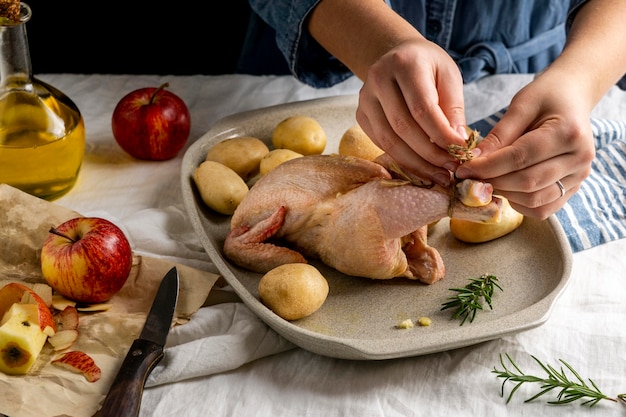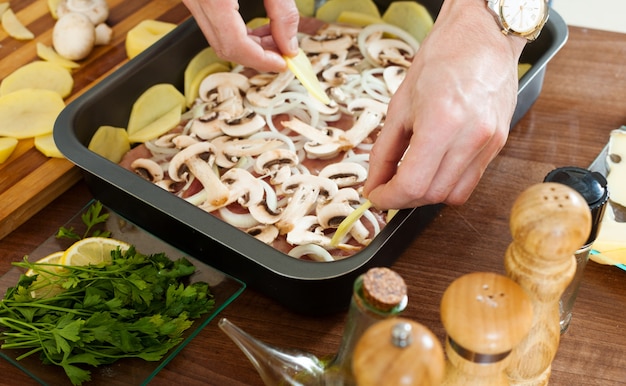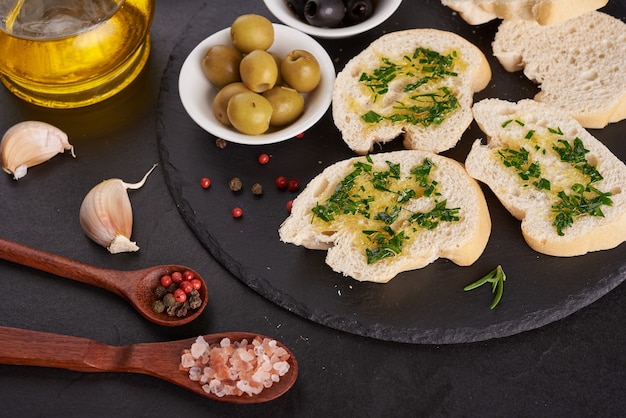Ah, chicken. It's the culinary chameleon, adapting to any flavour profile, cooking method, and occasion. But sometimes, you crave something simple, utterly satisfying, and bursting with flavour. That's where Parmesan chicken shines. It's a dish that's become a staple in my kitchen, perfect for those nights when you need a quick, easy meal without sacrificing deliciousness. I'm talking crispy, golden-brown chicken coated in a cheesy, garlicky sauce – a truly irresistible combination. Trust me, once you try this recipe, you’ll be making it again and again.
(Part 1) The Journey Begins: My Quest for the Perfect Parmesan Chicken

My journey with Parmesan chicken started years ago, back in my student days when I was trying to navigate a tight budget and a rumbling stomach. I’d often find myself rifling through my cupboards for inspiration, and that's when I stumbled upon this simple yet delicious dish. Those first attempts were, well, let's just say a bit of a learning curve. Some were too dry, others too greasy, and a couple even ended up resembling charcoal briquettes. But with each try, I learned, adapted, and refined my technique, slowly but surely honing in on the ultimate recipe.
My First Attempt: A Disastrous Start
I remember it like it was yesterday. A Tuesday night, an empty fridge, and a growling stomach. I had a few chicken breasts, a block of Parmesan cheese, and a solitary garlic clove. My culinary skills were still in their infancy back then, so I simply dredged the chicken in flour, pan-fried it, and tossed it with some melted butter and grated Parmesan. The outcome? A dry, flavourless disappointment. The chicken was tough, and the cheese didn't do much to elevate the flavour. Let's just say, my spirits were pretty low.
Learning from My Mistakes: A Step in the Right Direction
Not one to be easily deterred, I decided to give it another go. This time, I delved into online recipes, hoping for some inspiration. I discovered the importance of properly breading the chicken, using a mix of flour, breadcrumbs, and Parmesan. I also learned that adding milk to the breading mixture helped create a crispy, juicy coating. The second attempt was definitely an improvement. The chicken was juicier, and the breadcrumbs created a satisfying crunch. But something was still missing – it lacked that certain "je ne sais quoi".
(Part 2) The Turning Point: Finding My Signature Touch

The turning point came when I decided to add a touch of garlic and lemon to the recipe. The garlic introduced a savoury depth of flavour, while the lemon juice brightened everything up. I also experimented with different types of Parmesan, eventually settling on a sharp and nutty variety that complemented the chicken perfectly. It was at that moment that I realized the key to an incredible Parmesan chicken wasn't just about the ingredients but also about how they were combined and the cooking technique used.
The Secret to Juicy and crispy chicken
It took a few more rounds of experimentation, but I finally cracked the code. I found that using a combination of pan-frying and baking was the best way to achieve both juicy and crispy chicken. Pan-frying the chicken first creates a beautiful golden-brown crust, while baking it afterwards ensures it cooks through evenly and stays moist. I also discovered that letting the chicken rest for a few minutes after cooking allows the juices to redistribute, making a huge difference in the texture. This simple trick transformed my chicken from dry and disappointing to succulent and flavourful.
The Magic of the Parmesan Sauce
Of course, no Parmesan chicken would be complete without a delectable sauce. I experimented with different combinations of butter, Parmesan, garlic, and lemon juice, and after much tweaking, I came up with a sauce that was creamy, flavourful, and simply irresistible. It's the kind of sauce that beautifully coats the chicken, adding a layer of richness and umami that truly elevates the dish.
(Part 3) The Recipe: My Ultimate Parmesan Chicken

This is my ultimate Parmesan chicken recipe, the one perfected through countless trials and errors. It's a recipe I've shared with friends and family, and it always goes down a storm. It's that good!
Ingredients:
- 4 boneless, skinless chicken breasts (about 1 1/2 pounds)
- 1 cup all-purpose flour
- 1 teaspoon garlic powder
- 1 teaspoon dried oregano
- 1/2 teaspoon salt
- 1/4 teaspoon black pepper
- 1/2 cup milk
- 1 cup breadcrumbs (I prefer panko)
- 1/2 cup grated Parmesan cheese
- 2 tablespoons olive oil
- 2 cloves garlic, minced
- 1/4 cup lemon juice (freshly squeezed is best)
- 1/2 cup butter (unsalted)
- 1/2 cup grated Parmesan cheese
- Salt and pepper to taste
Instructions:
- Preheat your oven to 375°F (190°C). Line a baking sheet with parchment paper.
- In a shallow dish, whisk together the flour, garlic powder, oregano, salt, and pepper. In a separate shallow dish, combine the milk, breadcrumbs, and 1/4 cup of Parmesan cheese.
- Dip each chicken breast into the flour mixture, ensuring it’s fully coated. Then dip it into the milk mixture, making sure to coat it completely. Finally, dip it back into the flour mixture, pressing gently to ensure a good coating. You can repeat the milk and flour steps for an extra crispy coating.
- Heat the olive oil in a large skillet over medium heat. Add the chicken breasts to the skillet and cook for 5 minutes per side, or until golden brown. Don't overcrowd the pan, cook in batches if necessary.
- Transfer the chicken breasts to the prepared baking sheet. Bake for 15-20 minutes, or until cooked through. An instant-read thermometer inserted into the thickest part of the chicken should register 165°F (74°C).
- While the chicken is baking, prepare the sauce. In the same skillet, melt the butter over medium heat. Add the minced garlic and cook for 1 minute, until fragrant. Stir in the lemon juice and 1/4 cup of Parmesan cheese. Cook for 1 minute, until the cheese is melted and the sauce is smooth. Season with salt and pepper to taste.
- Remove the chicken from the oven and let it rest for 5 minutes before slicing. Pour the sauce over the chicken and serve immediately.
(Part 4) Tips and Tricks for Parmesan Chicken Perfection
Now let's talk about some tips and tricks that will take your Parmesan chicken to the next level.
Choosing the Right Chicken
Start with fresh, high-quality chicken breasts. I usually opt for free-range, organic chicken whenever possible. It makes a difference in the flavour and texture. You can also use chicken thighs if you prefer, but be sure to cook them for a little longer. If you’re short on time, you can also use frozen chicken breasts. Just make sure to thaw them completely before cooking.
Breading Techniques
The key to achieving that perfect crispy coating is in the breading technique. You can use any type of breadcrumbs you like, but I find that panko breadcrumbs provide a particularly satisfying crunch. Make sure to coat the chicken evenly in the breading mixture, pressing it gently to help it adhere. If you're feeling adventurous, you can even add some spices or herbs to the breadcrumb mixture, like paprika, rosemary, or thyme. It's a great way to add some extra flavour to your chicken.
Cooking the Chicken to Perfection
As I mentioned before, a combination of pan-frying and baking is the best way to ensure that the chicken is cooked through and crispy. Make sure to heat the skillet well before adding the chicken. This will help to create a crispy crust. Avoid overcrowding the skillet, as this will make the chicken steam instead of brown. And remember, the chicken is done when it reaches an internal temperature of 165°F (74°C). Use a meat thermometer to check the temperature.
The Parmesan Sauce
The Parmesan sauce is the star of the show. You can adjust the amount of garlic and lemon juice to your liking. If you prefer a stronger garlic flavour, add an extra clove or two. And if you're not a fan of lemon, you can omit it entirely or use a different citrus fruit, like lime or orange. Remember to use a good quality Parmesan cheese, as it makes a huge difference in the flavour.
Serving Suggestions
Parmesan chicken is incredibly versatile and can be served with a variety of sides. A classic pairing is with a side of pasta, but it also goes beautifully with roasted vegetables, mashed potatoes, or a simple salad. For a lighter option, try serving it with a bed of greens and a lemon vinaigrette.
(Part 5) Parmesan Chicken: A Global culinary adventure
Parmesan chicken is a dish that transcends borders and cultures. It's a testament to the beauty of culinary fusion, where different flavours and techniques come together to create something truly special. Having travelled and experienced diverse cuisines around the world, I’ve found that Parmesan chicken is a dish enjoyed everywhere I go.
Italian Roots
Of course, Parmesan chicken has its roots in Italy, the land of delicious cheese and pasta. The combination of Parmesan cheese and chicken is a classic Italian pairing, found in many traditional dishes. Think of Chicken Parmesan, a beloved Italian-American classic, or Pollo al Limone, a simple yet flavorful chicken dish with lemon sauce. These dishes are a testament to the Italian love for simplicity and flavour.
Asian Influences
Parmesan chicken has also been influenced by Asian cuisine. Many Asian cultures use a combination of soy sauce, garlic, and ginger to create flavorful sauces. The addition of soy sauce to the Parmesan sauce adds a savory umami flavour that elevates the dish. And if you’re looking for a more Asian-inspired flavour profile, you could even add a touch of sesame oil or chili flakes to the breading mixture.
American Fusion
In the United States, Parmesan chicken has become a modern comfort food. It's a dish that's easy to make, affordable, and universally loved. It's a testament to the American love for fusion cuisine, where different culinary traditions come together to create something truly unique.
(Part 6) Beyond the Recipe: Exploring the World of Parmesan
Parmesan cheese is more than just an ingredient in my favourite chicken recipe. It's a culinary icon, a staple in kitchens around the world. It's a cheese with a rich history and a flavour that's both bold and complex. I'm always fascinated by the history of food, and Parmesan is no exception.
The History of Parmesan
Parmigiano-Reggiano, as it’s officially called, has been made in Italy for centuries. It's a hard, granular cheese with a distinct nutty flavour and a slightly salty finish. The production process is strictly regulated, with specific guidelines for the milk, the aging process, and the region where it can be produced. This dedication to quality is what gives Parmesan its unique character.
Types of Parmesan
While Parmigiano-Reggiano is the most famous type of Parmesan, there are other varieties available. Some are made with cow’s milk, others with sheep’s milk, and some even use a blend. Each type has its own unique flavour profile, from mild and buttery to sharp and salty. I always encourage people to experiment and try different types to find their favourite. You never know what culinary treasure you might discover.
Parmesan Beyond Chicken
Parmesan cheese is incredibly versatile and can be used in a wide variety of dishes. It's a classic topping for pasta, a delicious addition to soups and stews, and a flavorful ingredient in sauces and dips. You can even grate it over vegetables, pizzas, and salads. I've even experimented with using it in desserts, like a Parmesan shortbread cookie, which was surprisingly delicious.
(Part 7) Parmesan Chicken: A culinary journey for the Senses
Parmesan chicken is more than just a recipe. It's a culinary journey for the senses. It's a dish that evokes memories, sparks conversations, and brings people together. It's a celebration of food, flavour, and the joy of cooking.
The Aroma of Garlic and Parmesan
The first thing that hits you when you make Parmesan chicken is the aroma of garlic and Parmesan cheese. It's a warm and inviting scent, the kind that fills your kitchen with a sense of anticipation. It's a smell that instantly transports you to a cozy Italian trattoria, where you can almost imagine the chatter of diners and the clinking of glasses.
The Crunch of the Breading
The next thing you'll notice is the satisfying crunch of the breading. It's a sound that’s both crisp and delicate, a testament to the perfect balance of flour, breadcrumbs, and Parmesan. It’s a sound that promises a delightful textural experience, a contrast between the crisp exterior and the juicy interior of the chicken.
The Flavour Fusion
Finally, there's the explosion of flavour. The chicken is juicy and tender, with a hint of saltiness from the Parmesan and a touch of acidity from the lemon juice. The sauce is creamy and rich, with a garlicky depth that perfectly complements the chicken. It's a symphony of flavours that dances on your tongue, leaving you wanting more.
(Part 8) Parmesan Chicken: More Than Just a Dish
For me, Parmesan chicken is more than just a dish. It’s a reminder of the simple joys in life, the joy of cooking for loved ones, and the joy of sharing a meal together. It's a dish that brings people together, creating memories that last a lifetime. It’s also a reminder of the power of food to connect us, to transport us, and to remind us of the beauty of the world around us.
A culinary legacy
I’ve been making Parmesan chicken for years, and it’s a recipe that I’ve passed down to my children. It's become a family tradition, a dish that we all love and cherish. It’s a reminder that food is about more than just sustenance; it's about love, connection, and creating memories that will last a lifetime.
The Joy of Sharing
I love sharing my Parmesan chicken recipe with friends and family. It’s a dish that’s always a hit, and it’s always a pleasure to see people enjoy it. The best part is that it’s a recipe that’s easy to adapt and customize. You can add your own personal touch, make it your own, and create a dish that’s truly special.
FAQs
Q1: Can I use chicken thighs instead of breasts?
Yes, you can use chicken thighs for this recipe. However, you will need to adjust the cooking time slightly. Chicken thighs are naturally juicier than breasts and will take longer to cook through. Be sure to check the internal temperature of the thighs with a meat thermometer to ensure they are cooked to 165°F (74°C). You might also want to consider adjusting the baking time, as thighs tend to be thicker than breasts and may require longer to bake through.
Q2: Can I make this recipe ahead of time?
Yes, you can prepare the chicken ahead of time. Simply bread the chicken and store it in an airtight container in the refrigerator for up to 24 hours. When you’re ready to cook, remove the chicken from the refrigerator and let it come to room temperature for about 30 minutes. This will help the chicken cook evenly. You can also prepare the Parmesan sauce ahead of time and store it in the refrigerator for up to 3 days. Reheat it gently over low heat before serving.
Q3: Can I freeze the Parmesan chicken?
Yes, you can freeze cooked Parmesan chicken. Allow the chicken to cool completely before storing it in an airtight container or freezer bag. Frozen Parmesan chicken can be stored for up to 3 months. To reheat, thaw the chicken in the refrigerator overnight, then bake it in a preheated oven at 350°F (175°C) for 15-20 minutes, or until heated through. You can also reheat it in the microwave, but it might not be as crispy.
Q4: Can I use a different type of cheese?
While Parmesan cheese is the traditional choice for this recipe, you can use a different type of hard cheese, such as Pecorino Romano, Asiago, or even Gruyere. However, keep in mind that the flavour will be different. Pecorino Romano, for example, has a sharper, more pungent flavour, while Asiago has a milder, nuttier flavour. Gruyere is a Swiss cheese that has a slightly sweet and nutty flavour. Experiment and see what you like best!
Q5: What can I serve Parmesan chicken with?
Parmesan chicken is incredibly versatile and can be served with a variety of sides. Some classic pairings include pasta, mashed potatoes, roasted vegetables, and salads. You can also try serving it with rice, quinoa, or couscous. Get creative and experiment with different flavours and textures. For a complete meal, try pairing it with a green salad or roasted vegetables for a lighter option, or mashed potatoes or pasta for a more hearty meal.
Everyone is watching

Perfect Rice Every Time: The Ultimate Guide to Cooking Rice
Cooking TipsAs a self-proclaimed foodie, I've always been a bit obsessed with rice. It's the foundation of countless cuisi...

Prime Rib Roast Cooking Time Chart: Per Pound Guide
Cooking TipsPrime rib roast. Just the name conjures images of lavish dinners, crackling fires, and hearty laughter. It’s ...

The Ultimate Guide to Cooking Asparagus: Tips, Techniques, and Recipes
Cooking TipsAsparagus. The mere mention of this spring delicacy conjures up images of vibrant green spears, crisp and burs...

Ultimate Guide to Cooking the Perfect Thanksgiving Turkey
Cooking TipsThanksgiving. Just the word conjures up images of overflowing tables laden with delicious food, the scent of r...

How Long to Bake Potatoes in the Oven (Perfect Every Time)
Cooking TipsBaked potatoes are a staple in my kitchen. They're incredibly versatile, delicious, and surprisingly easy to m...
